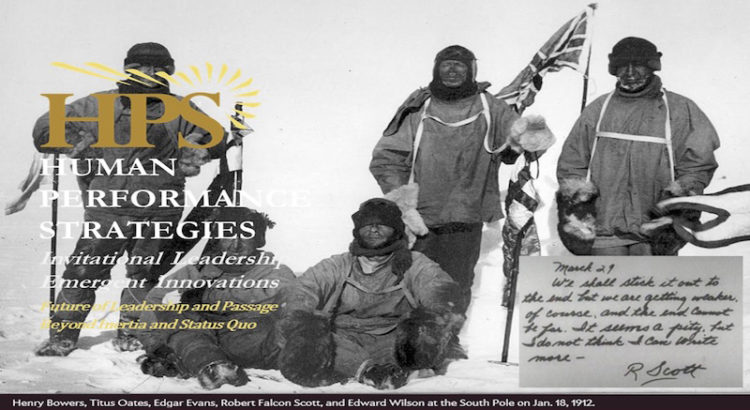Last December 14th marked the 105th Year Anniversary of the Norwegian explorer, Roald Amundsen, and his team’s successful expedition to the South Pole. His adversary, Captain Robert Falcon Scott of The Royal British Navy, and his team, raced Amundsen in a quest to see who could reach the South Pole first. Amundsen and his team were well-prepared and deliberate in their passage. Scott was set on winning at all costs. Scott and his team arrived at the South Pole on January 17, 1912, thirty-four days after Amundsen. On the return trip, Scott and his team perished of starvation and extreme cold (photo of Scott and his team).
In a world of increasing speed, limited resources, and intense global competition, there may be something to learn from these courageous explorers and their respective “passages.” In some cases, speed is essential to crossing the finish line first. The fable of the tortoise and the hare seems to apply here. In the case of the expedition to the South Pole, the tortoise (Amundsen and his team) not only finished first, but lived to tell about the adventure upon safely returning home.
Great by Choice, another brilliant work by Jim Collins, co-authored with Morten Hansen, was published in 2011. The research basis of the 300-page book comprised nearly 50-pages. In typical Collins style, his and Hansen’s extensive research underpinned the entire contents of the book. One chapter is entitled 20-Mile March and is based on Amundsen’s quest and the strategy he used to reach the South Pole ahead of Scott.
I mention the publication date above as so many wonderful books are read by well-intentioned leaders. Yet, the pearls of wisdom and practical applications contained within are seldom applied or sustained within most organizations. In my observations, far too many lose steam, become faint memories or flavors-of-the-month.
Amundsen and his team traveled no further than 20 miles per day regardless of good or bad weather conditions. He knew that driving his team to exhaustion would be counterproductive to or even jeopardize the expedition. He also exercised discipline to never exceed more than 20 miles per day, even in perfect weather conditions. His progress was steady, reliable and consistent and his arrival more than a month ahead of Scott speaks for itself.
In last week’s post, A SOURCE OF LIGHT FOR SAFE PASSAGE, I suggested that some passages occur quickly. I noted that time leading up to any change (event) can fuel anticipation or excitement or fear and anxiety depending on the situation. In the context of Amundsen’s and Scott’s “passages”, it was a much longer (process) in the course of their expeditions. Amundsen adopted a disciplined and methodical strategy. Scott, on the other hand, drove his team to exhaustion and adopted an erratic, unreliable and inconsistent strategy.
I am not debating the need for or merits of speed, optimizing resources or successful global competition. I am suggesting that we can learn from others’ “passages” – and their strategies, processes and outcomes – such as the expedition to the South Pole. We can also learn from the tortoise and hare. There is a time and place for both the tortoise and hare. However, we must always be mindful and not lose sight of what matters most in our lives. In the case of Captain Scott, he clearly lost sight and his vision proved fatal.
In the context of leadership, Amundsen and Scott had very different strategies and achieved very different results. Most leaders will never be faced with placing their teams and organizations in life-threatening situations. However, the 20-Mile March is applicable to any enterprise – public, private or non-profit. You can learn more about the 20-Mile March and other fascinating content in the book, Great by Choice. I recommend it highly.
“Victory awaits him who has everything in order – luck we call it. Defeat is definitely due for him, who has neglected to take the necessary precautions – bad luck we call it. ” – Roald Amundsen
Tips and Practical Applications:
- What most resonates with you about Amundsen’s and Scott’s expeditions? Perhaps you have experienced both strategies? How does the 20-Mile March apply to your role as a leader?
- Think of a time when you were a tortoise and what were the outcomes as a result? Do the same when imaging yourself as the hare. How do both apply to your role as a leader?
- Detailed and methodical planning and preparation do not come naturally to some – even exemplary leaders. If these attributes are not a strong suite for you, then find someone on your team who can ensure that these tasks are completed before the expedition gets underway.




Great story, research and application.